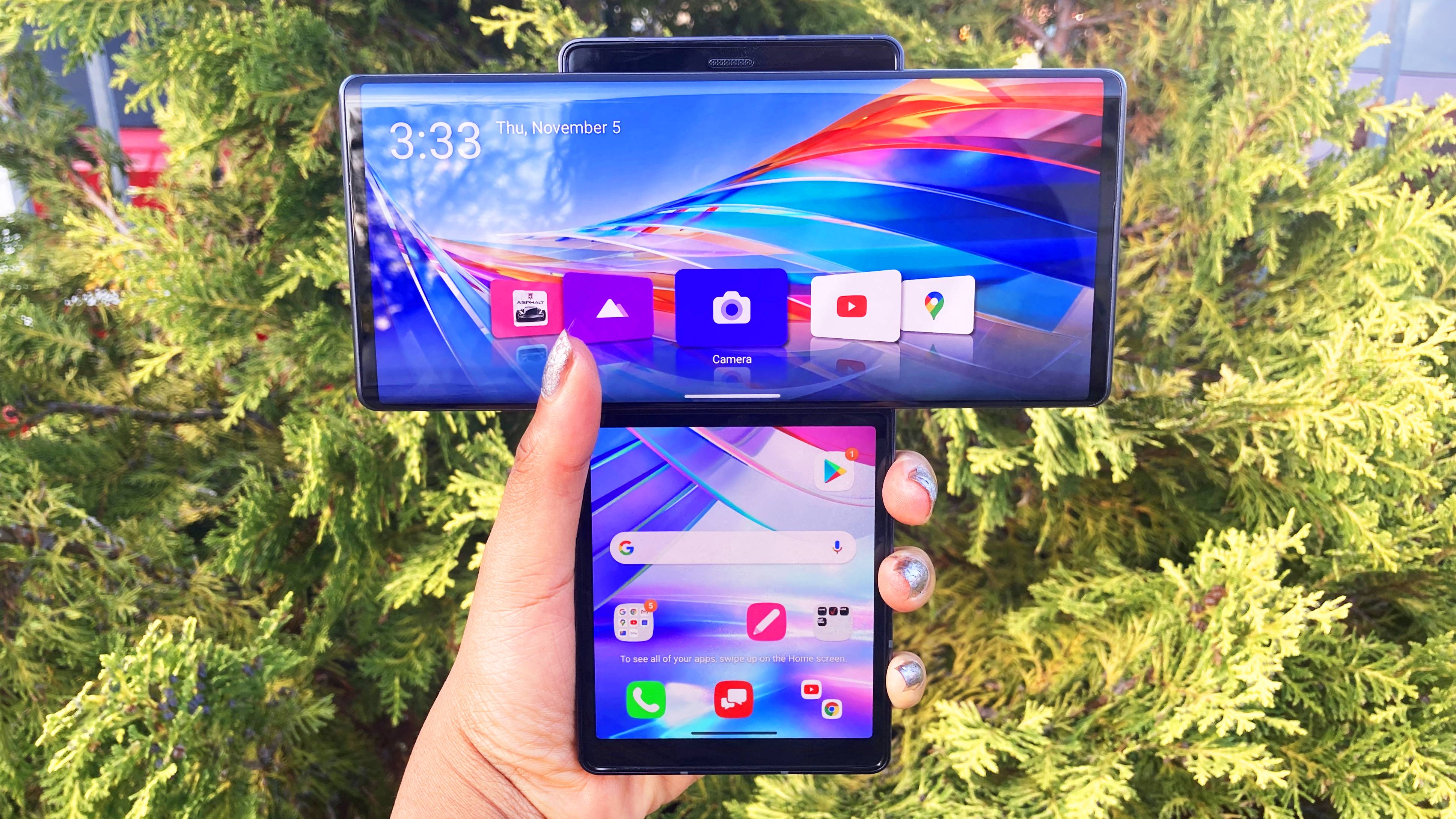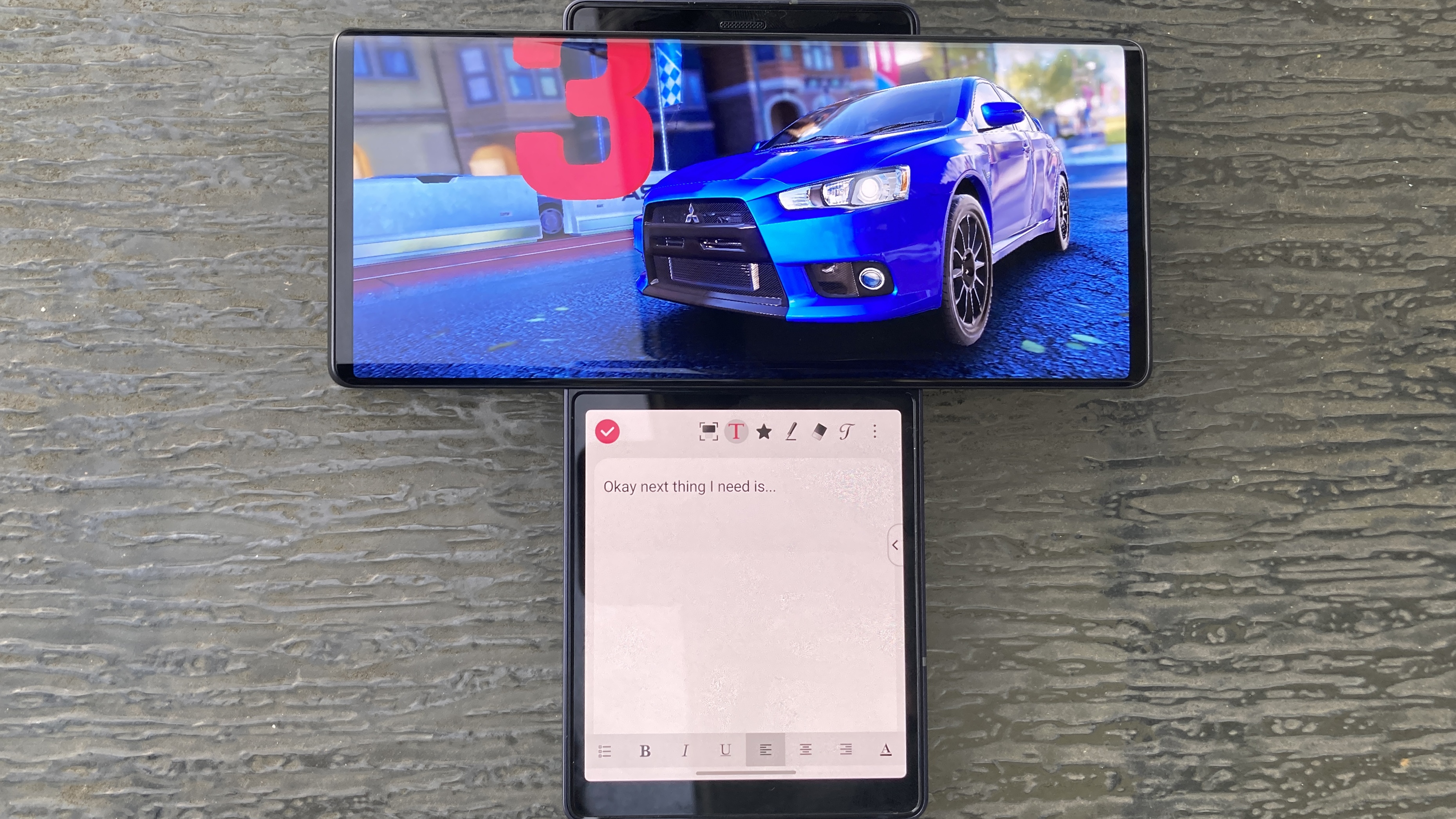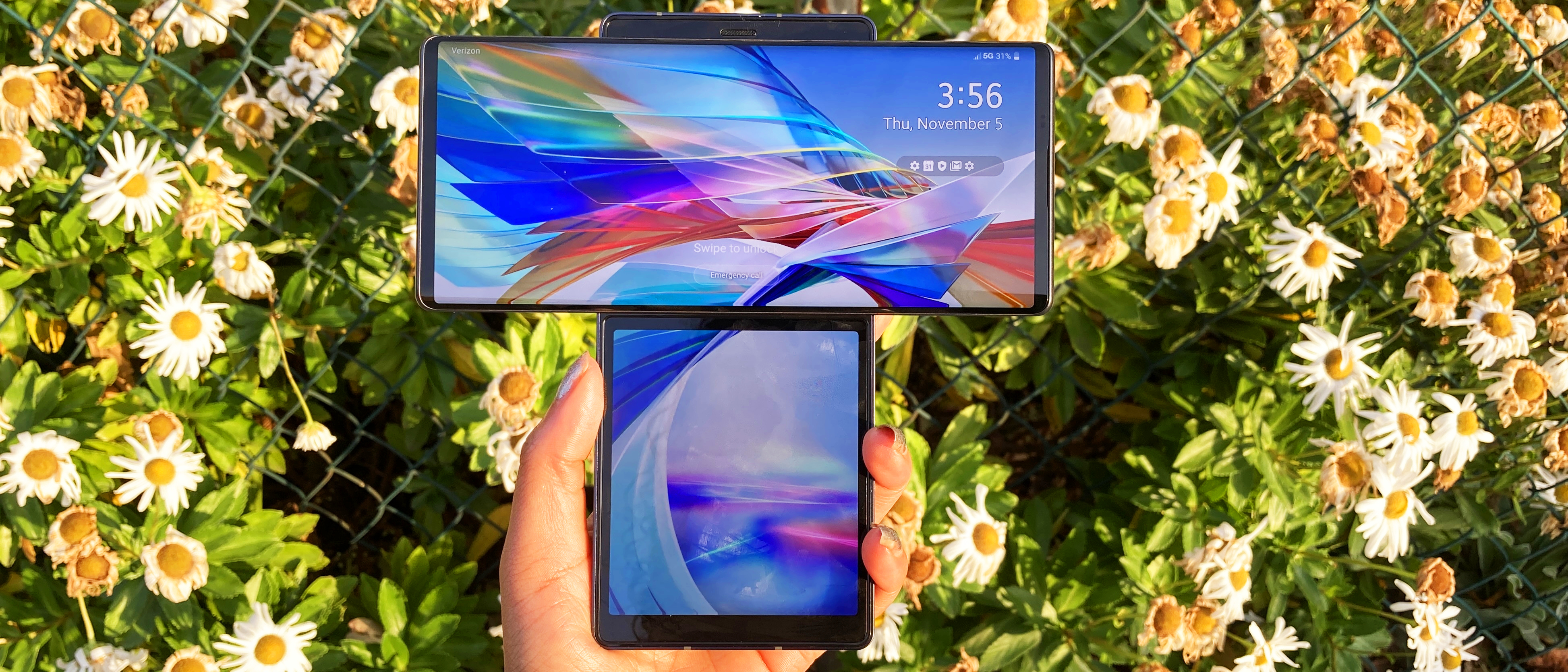Laptop Mag Verdict
The LG Wing is a stellar swivelling smartphone with cool camera features that appeal to vloggers, but it has underperforming internals.
Pros
- +
Bright, color-accurate OLED displays
- +
Pop-up selfie camera
- +
Innovative, T-shaped design
- +
Simultaneous rear-and-front video recording
- +
Awesome app juggling
Cons
- -
Past-gen CPU
- -
Middling performance
Why you can trust Laptop Mag
Price: $999
OS: Android 10
Main display: 6.8-inch, 2460 x 1080 (OLED)
Second display: 3.9-inch, 1240 x 1080 (OLED)
CPU: Qualcomm Snapdragon 765G
RAM: 8GB
Rear cameras: 64MP (f/1.8), 13MP (f/1.9) ultra-wide lens, 12MP (f/2.2)ultra-wide big pixel
Front camera: 32MP (f/1.9) wide lens
Storage: 256GB
Battery: 7:21
Size: 5.78 x 2.82 x 0.29 inches
Weight: 0.4 pounds
The LG Wing — a futuristic, T-shaped smartphone — is like the eccentric, kitschy painting folks hang up in their living room. It’s odd-looking and bizarre, but it invites thought-provoking conversation, evokes a multitude of emotions, and adds character to your humble abode.
The Wing isn’t so much a smartphone — it’s a conversation piece. This isn’t the phone you get if you want to have the zippiest processor or the sleekest, lightest device. Rather, the Wing is for quirky folks who love to stand out of the crowd with unique, bold and flashy possessions that’ll attract meaningful exchanges with strangers — and maybe a little envy.
The Wing is also perfect for multitasking masters who feel shackled by the limitations of single-screen devices. On this device, I’ve watched Food Network cooking videos on the main screen while shopping for kitchenware on the second. I also found myself watching Netflix’s Grand Army while texting a friend about the wild, visceral plot. The combinations of apps you can use simultaneously on this dual-screen masterpiece are endless. Lastly, the LG Wing targets filmographers and vloggers with dual-lens video recording and gimbal mode.
The Wing isn’t for everyone, though. Its weird design is an acquired taste and its internals aren’t flagship quality, but if you’re on the hunt for a badass dual-screen smartphone, the Wing will capture your attention.
LG Wing price and configurations
The LG Wing costs $999. There’s only one configuration equipped with 8GB of RAM and 256GB of storage. If that’s not enough for you, you can expand your storage by up to 2TB with a microSD card.
The Wing is currently available at Verizon. The smartphone will hit store shelves at AT&T and T-Mobile on Nov. 6. With an eligible trade-in and an unlimited plan, Verizon and AT&T customers can snag the Wing at a discount of up to $700 and $750, respectively.
The Wing comes in Aurora Gray and Illusion Sky.
Sign up to receive The Snapshot, a free special dispatch from Laptop Mag, in your inbox.
LG Wing design
I once joked that the LG Wing looks like a futuristic cross one could use to ward off unholy beings while yelling, “I rebuke you!”

Alas, LG Vampire Repellent doesn’t roll off the tongue, so the Korea-based tech giant opted for “LG Wing” to describe its funky design. At first, the Wing looks like a typical Android flagship smartphone with a spacious display, but the 6.8-inch top screen can be swiveled into the smartphone’s “wing.” Swooping it into a T-shaped position is satisfying and addicting — in the same way flippy Sidekicks were fun in the early 2000s. Below the wing, you’ll find a 3.9-inch screen with slightly thicker bezels.
Don’t worry — the hinges that support the main screen’s swivel are sturdy. The Wing’s flawless swivel performance persisted after being tested 200,000 times and the phone is IP54 certified, which means it is rated for high water and dust resistance.

When the screen is unswiveled, it goes into what LG calls “basic mode,” but this phone is anything but basic. As a single-screen smartphone, the Wing has a gorgeous 6.8-inch display. There’s no hole-punch cutout or unattractive notch (ahem, Apple) interrupting the screen-to-body ratio. The top and bottom frames of the Wing are ultra-slim while the sides are virtually bezel-less.
You may be wondering, “There’s no hole-punch cutout or notch, so where’s the front-facing camera?” The Wing features a pop-up camera, located on the top-left edge, that protracts when selfie mode is switched on in the camera app.
Next to the pop-up camera, you’ll find a mic. On the left edge is a microSD card slot. On the bottom edge, you’ll discover another mic, a USB-C port and speakers. On the right edge, are the volume buttons and the side button, which you can use to awaken the device. There is no headphone jack, but a USB-C-to-3.5mm port dongle is included in the box. You can also use wireless headphones.

My review unit has the Aurora Gray color, which coats the chassis with a reflective, silver finish. It’s nothing to write home about — the color isn’t striking, but the glossiness makes it pop. The back features a three-camera array on the top-left corner of the chassis, giving the Wing a three-eyed Cyclops look.
The LG Wing (0.4 inches thin, 0.57 pounds), when closed, is slightly thicker and heavier than the Microsoft Surface Duo (0.38 inches thin, 0.55 pounds). However, in comparison to another dual-screen rival, the Samsung Galaxy Z Fold 2 (0.6 inches thin, 0.61 pounds), the Wing is slimmer and lighter. The Wing fit like a glove in my jeans’ back pockets, but the LG device was too large to slip inside my front pockets.
LG Wing dual-screen displays
One of the Wing’s greatest selling points is its OLED dual-screen displays. The main, 6.8-inch, 2460 x 1080-pixel screen can be swiveled up into a wing state or swung back to simulate a single-screen device. The damn-near non-existent bezels — and the absence of a notch — gives this spacious, edge-to-edge display humongous screen real estate.
I watched The Old World: A Mindtrip Through Europe trailer, and as a flaming biker rode through a forest, the Wing’s main screen captured the flickering orange, yellow and red fiery hues that emanated from the back of the cyclist.

Scenic shots were captivating; I could almost feel the crunchy texture of snowy landscapes and the humid, muggy atmosphere of verdant jungles. In one close-up shot of an actor, I could spot the tiny pores that populated his mocha-complected skin.
I’ve seen more colorful, sharper displays, but the LG Wing’s 6.8-inch screen is adequate for a pleasurable viewing experience.
Let’s not forget about the 3.9-inch, 1240 x 1080-pixel second display. This screen works best as a companion to the main display rather than a viewing platform. For example, while watching a YouTube video on the “wing,” you can use the second display as a control panel to manage brightness, volume, fast-forwarding, pausing and more. The second display is also perfect for uninterrupted note-taking, texting and web browsing while watching videos or gaming on the main screen.

If someone calls while watching a show on Netflix, Disney+ or any other streaming app, you can pick it up without needing to pause the content. The app combinations are seemingly endless, but one thing you cannot do ( unlike the Surface Duo) is use the camera app while engaging with the second screen.
Although I do not recommend the second screen for watching videos, I felt compelled to test it. I watched the Free Guy trailer on the 3.9-inch display; to reduce the letterboxing effect, I had to rotate the device so that the swivel display had a vertical orientation and the second screen protruded from the right. As Ryan Reynolds dodged the perils of a chaotic, video-game world, colors were punchy and close-up shots of actors revealed subtle facial features such as Reynold’s smile lines and Lil Rel Howery’s pores.

The LG Wing, according to our colorimeter, covered 105% of the DCI-P3 color gamut, which pales in comparison to the average smartphone (109%). The Surface Duo (140%) and the Galaxy Z Fold 2 covered more of the DCI-P3 color space (146%).
We tested the LG Wing's screen brilliance in two states: with adaptive brightness on and with adaptive brightness off. With the former, the LG Wing emits 643 nits of brightness. However, with the latter, the LG Wing radiates only 357 nits of brightness. With adaptive brightness on, the Galaxy Z Fold 2 offers 599 nits of brightness, but when it’s off, the Samsung device emits 361 nits of brightness. The Surface Duo, which lacks an adaptive brightness setting, sports 460-nit dual screens. The Wing, with adaptive brightness on, is the brightest of them all.
On the Delta-E color accuracy test, the Wing scored 0.23 (lower is better). LG’s dual-screen rivals have two screen settings. The Surface Duo has a default option and a second setting called “sRGB” while the Galaxy Z Fold 2 also has a default state and a second option called “Vivid.” The default Delta-E scores for the Microsoft and Samsung devices are 0.33 and 0.25, respectively. When sRGB mode is switched on the Surface Duo, the screens land a Delta-E score of 0.27. When the Galaxy Z Fold 2’s Vivid setting is on, its displays offer a Delta-E score of 0.34.
No matter which screen setting is on, the Wing is more color accurate than both the Surface Duo and the Galaxy Z Fold 2.
LG Wing audio
The LG Wing sports a single speaker on the bottom edge of the second screen. Another set of speakers on the swivel screen would have been ideal, but I’m sure LG engineers would have lost their minds trying to implement speakers on such a ridiculously thin display.

I listened to “Put Your Records On” by Ritt Momney, and the more I amplified the volume, the more the quality plummeted. At max volume, the audio was loud enough to fill my medium-sized testing room, but it lacked that smooth, buttery sound that makes a listening experience feel heavenly. Mids sounded fine, but highs have a little bit of grit and grain at max volume. Rutter’s vocals lacked that crisp, lush sound you’d hear on speakers that produce warm, well-balanced audio.
Fortunately, there is a pre-installed equalizer app that you can play around with. The app offers 13 pre-set sound profiles: Classic, Pop, Rock, Hip Hop, Jazz Latin, Acoustic, Electronic, Lounge, Soft Lounge, Vocal Booster and Treble Booster. After experimenting with all 13 sound profiles, my favorite is Vocal Booster — it is the only option that rectified the minor muddiness issue that plagued vocals on the Wing’s speakers.
Overall, the Wing’s audio sounds decent and LG did the best it could with the space limitations and constraints of a T-shaped, dual-screen smartphone.
LG Wing performance
The LG Wing packs a Qualcomm Snapdragon 765G SoC, which isn’t a flagship-tier processor, but I’m going to cut LG some slack — this chipset helps to keep the price point under $1,000 and saves on power consumption. I’m also not sure the Wing even needs a top-of-the-line CPU because it has no intention of offering cutting-edge perks, such as 8K video recording.

Equipped with 8GB of RAM, the Wing had no issues juggling 15 Google Chrome tabs on the second display while I blasted Netflix on the main display.
On the Geekbench 5 overall performance test, the Wing achieved a score of 1,891, which stumbles behind the average smartphone (2,909). The Wing also couldn’t compete with the Surface Duo and the Galaxy Z Fold 2. The Microsoft foldable, equipped with a Qualcomm Snapdragon 855 CPU, outputted a score of 2,862. The Galaxy Z Fold 2, powered by the au courant Qualcomm Snapdragon 865+ chip, crushed the LG and Microsoft smartphones with a knock-out score of 3,130.
On the 3DMark Slingshot Extreme test, a demanding graphics benchmark, the Wing served up an embarrassing score of 3,279, which falls short of the category average (5,035). The Wing couldn’t conquer the Surface Duo (5,866) nor the Galaxy Z Fold 2 (7,684).

The GFXBench 5 benchmark also measures graphics performance. The Wing managed 1,505 frames (23 frames per second) on the Aztec Ruins in Normal Tier Off-screen, which is unimpressive compared to the average smartphone (1,938). The Wing’s score also pales in comparison to the Microsoft Surface Duo (2,733, 43 fps) and the Samsung Galaxy Z Fold 2 (3,824, 60 fps).
On the JetStream 2.0 benchmark, a Web browser test designed to measure JavaScript performance, the Wing offered a score of 57.6. The LG device got pulverized by the Surface Duo (68.5) and the Galaxy Z Fold 2 (74).
On the MobileXPRT 3 benchmark, a test designed to evaluate the capabilities of Android OS, the Wing achieved a score of 1,692, which plods behind the Surface Duo (2,057) and the Galaxy Z Fold 2 (3,824).
LG Wing battery life and charging
Dual-screen displays will suck the soul out of a device’s battery life. Despite the power inefficiency of a double-screen setup, the Wing showcased decent endurance on the Laptop Mag battery test (continuous web surfing at 150 nits on a cellular network).
With both screens open, the Wing lasted 7 hours and 21 minutes, which, as expected, is less than the category average (9:56). The Wing outlasted the Surface Duo (7:14), but the Galaxy Z Fold 2 remained active for a whopping 10 hours and 10 minutes. That’s longer than the iPhone 12 and the iPhone 12 Pro’s 8-hour runtime, and those devices have only one screen.
When we tested the charging speed of the Wing, it climbed to 30% in 15 minutes and 57% in 30 minutes.
LG Wing cameras
The LG Wing has three rear cameras: two 12MP and 13MP ultra-wide cameras, and a 64MP wide camera with ultra-high resolution and optical image stabilization. The Wing also has a 32MP pop-up selfie camera.
Front-facing, pop-up camera
Taking selfies on the Wing’s 32MP pop-up camera sent me sprinting to make an appointment with my dermatologist. The Wing’s selfie camera is highly detailed, crisp and color accurate. This lens picks up on subtle facial imperfections that the naked eye wouldn’t spot. Every bump, wrinkle, pore and molecule was captured on this camera.

The Portrait setting has several submodes you can play with, including Blur, 3D Photo Effect, Cartoon Background, Sketch Background, Color Focus, Panning, Zoom, Stage Light and Stage Light Mono. There’s also a Sticker mode that offers Snapchat-esque filters that superimposes cute rabbit ears, flower crowns and more on your face. Animated filters are not my cup of tea, but it’s a fun feature for kids and social media fanatics. Check out the gallery below to see how those selfies turned out.

LG Wing - Blur

LG Wing - Cartoon Background

LG Wing - Color Focus

LG Wing - Stage Light

LG Wing - Sticker filter
Wide
I took the LG Wing’s cameras for a spin at a Long Island park. The 64MP standard camera performed fairly well, capturing the pale greens, orangey yellows and earthy browns that contributed to the park’s autumn ambiance. The pond’s ripples, formulated by three swimming ducks, are detailed and defined.

However, I noticed that the ducks seem to blend into the background. When I took the photo, I wanted the ducks to be one of the main focal points of this photo, but they’re indistinct. Perhaps this could be rectified by a lens that offers higher contrast photos.
Zoom
The LG Wing does not have a telephoto camera, but you can still acquire a decent 2x zoom from the standard 64MP lens.

The zoom feature is optimal for framing a desired subject as the focus, and in this case, the bridge is spotlighted. Compared to the photo above, this zoomed-in photo offers more verdant grass, sharper ripples and a closer look at the melange of greens, yellows and orange hues that paint the leaves.
Ultra-wide
The 13MP ultra-wide camera offers a sweeping, 117-degree view of your surroundings.

The photos make it seem as if I was yanked back 10 feet, capturing all the foliage, bark, grass and pond the camera can manage. Compared to the 64MP camera photos, the quality on the 13MP ultra-wide lens drops slightly with less color accuracy and decreased sharpness.
Dual-lens video recording
The Wing’s most jaw-dropping camera features are activated during swivel mode. Vloggers will love the Wing’s unique ability to record videos using the front-facing and rear lenses simultaneously.

YouTubers, TikTokers and other social media content creators will find this tool to be incredibly handy — solo vloggers can record what’s in front of them while still capturing their own facial expressions. I was impressed by the quality of the videos I captured, too. The Wing’s front-facing camera is good — too good — reproducing blemishes, scars and bumps that I never noticed before. The 12MP rear camera (the lens dual-recording mode uses) is also magnificent, capturing true-to-life, crisp and detailed videos. I was disappointed, though, that when I checked the gallery to replay my saved dual recordings, the videos were not stitched together; they were saved as separate recordings.
Gimbal mode
Gimbal mode, also only available in swivel orientation, lets users pan the 12MP rear camera using joystick controls on the second display.

This amazing feature allows you to capture video with unrivaled steadiness. If your subject is moving, you needn’t move your hand one inch — you can simply use the joystick controls to pan the camera left, right, up and down for professional, stabilized video content.
Night Mode
Night Mode is not featured on the front-facing, selfie camera, which is unfortunate. If you want to take a selfie in a low-lit environment, you can always use the rear lenses, but you won’t have a viewfinder.

I tested the LG Wing’s Night Mode feature (it’s called “Night View” on the device) in my neighborhood, and it’s simply alright. The trees look like silhouettes, there’s some lens flare from traffic lights and street lamps, and the quality isn’t the sharpest, but it does the job.
Capturing Night Mode photos requires you to keep the phone completely still for about nine seconds, which can be more challenging than you think. The more motionless you are, the more in-focus your Night Mode photos will be.
LG Wing software and warranty
The LG Wing runs Android 10 and has a cornucopia of pre-installed apps, including an unsurprising slew of Google properties (e.g. YouTube, Gmail, Maps, Drive, Duo, Docs, Sheets, Slides and Photos), an abundance of bloatware games (e.g. Asphalt 9, Candy Crush Saga, WordWars, Ball Blast, Heroes, Scrabble Go) and a handful of shopping apps (e.g. Amazon Shopping, Wish and Caviar).

Similar to the Surface Duo, the Wing allows you to group two of your apps together on the home screen so that they can launch simultaneously. You can, for example, lump YouTube and Google Chrome together, and with one tap, YouTube will launch on the main screen and Chrome will appear on the second screen.
As a single-screen smartphone, the UI operates like any other Android device. You can swipe through several pages of apps and stumble upon an integrated Google search bar for quick queries. When the Wing is in swivel mode, the main 6.8-inch screen switches to a new interface that features a carousel of apps for quick launching: Asphalt 9, Gallery, Camera, YouTube and Maps.
The second screen sports a miniature version of the well-recognized Android UI with the Google search bar in the center and several apps populated throughout the screen. On the top-right corner, you can select which apps you’d like to launch on the second display by default.
Whether the Wing is in single-screen mode or swivel mode, the UI is intuitive and easy to use. The LG Wing comes with a one-year limited warranty.
Bottom line
The LG Wing is a show-stopping, swiveling smartphone that will turn heads everywhere you go. The Wing isn’t the zippiest smartphone on the market, but I’d argue it’s the most innovative. If you’re seeking a dual-screen smartphone with industry-leading specs, consider the Samsung Galaxy Z Fold 2, but keep in mind those better-performing internals will cost you a whopping $999 more.

The Wing compensates for its performance slog with a conversation-stimulating design, two attractive OLED displays, an addictive swivel function, unique video-recording features, decent battery life (for a dual-screen device) and impressive multitasking capabilities.
Vloggers and other content creators will salivate over the dual-lens recording feature that can record using the rear and selfie lenses simultaneously. Filmographers will enjoy gimbal mode for producing steady, stabilized professional content. And multitaskers will gush over the Wing’s app juggling prowess. The LG Wing isn’t a gimmick — its T-shaped posture offers a wealth of advantages for high-productivity users and I highly recommend it.
Kimberly Gedeon, holding a Master's degree in International Journalism, launched her career as a journalist for MadameNoire's business beat in 2013. She loved translating stuffy stories about the economy, personal finance and investing into digestible, easy-to-understand, entertaining stories for young women of color. During her time on the business beat, she discovered her passion for tech as she dove into articles about tech entrepreneurship, the Consumer Electronics Show (CES) and the latest tablets. After eight years of freelancing, dabbling in a myriad of beats, she's finally found a home at Laptop Mag that accepts her as the crypto-addicted, virtual reality-loving, investing-focused, tech-fascinated nerd she is. Woot!


